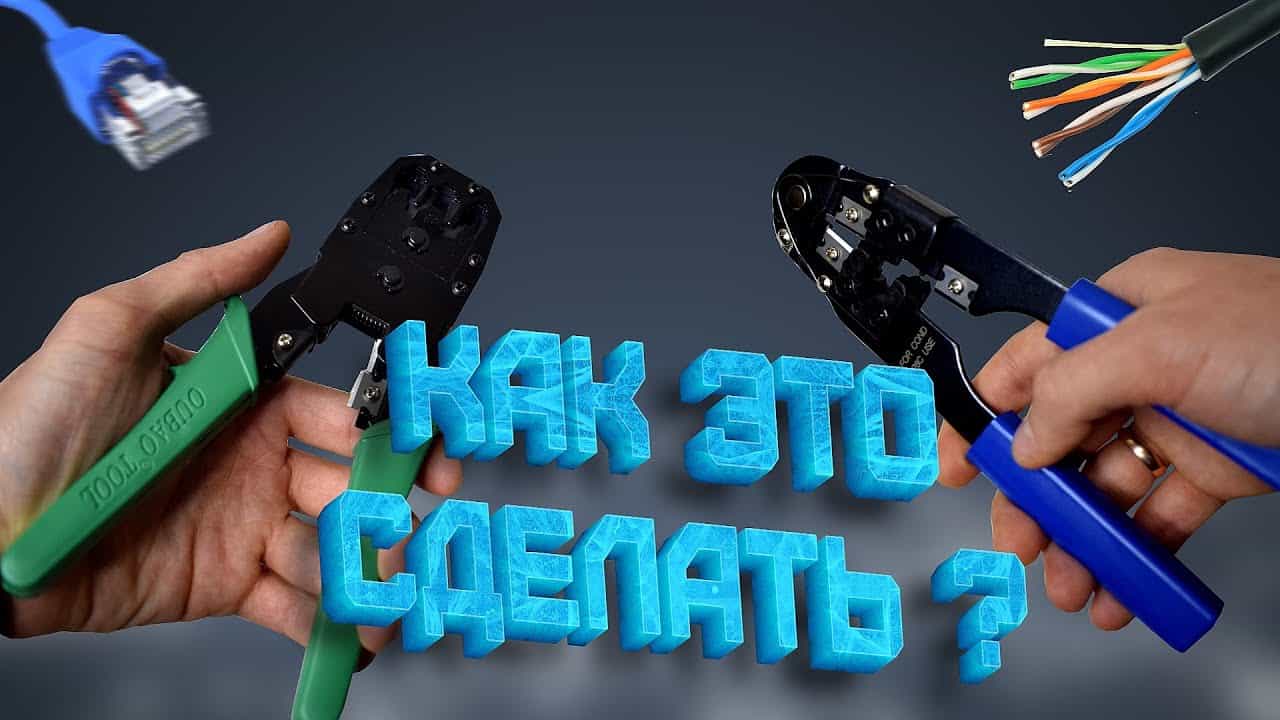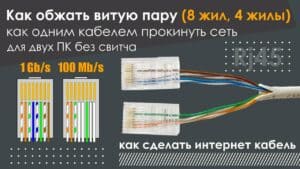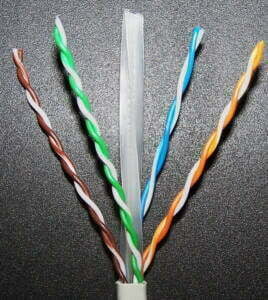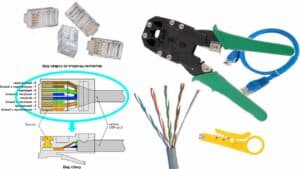- What is twisted pair and what is it used for?
- Frequently Asked Questions About Twisted Pair Crimping
- 1. What tool do I need to crimp twisted pair cable?
- 2. How do I know what size connector I need?
- 3. How can I make sure the connector is installed correctly?
- 4. How can I check the functionality of the cable after crimping?
- How to choose the right type of twisted pair for a specific application
- What to do if a crimped cable does not work: main causes and solutions to problems
- What mistakes should be avoided when crimping twisted pair cables?
What is twisted pair and what is it used for?
Twisted pair is a cable consisting of several pairs of insulated conductors twisted together. Each pair of conductors consists of strands that are insulated from each other but twisted together. This type of cable is widely used in data networks. Twisted pairs have high protection against electromagnetic interference and signal loss over long distances. Twisted pairs can be used for data transmission in local networks, the Internet, telephony and television. It can be used both indoors and outdoors. Thanks to its structure and protection from interference, twisted pair is a reliable and stable data cable. One of the important elements in using twisted pair is proper crimping. The cable must be crimped in such a way that the contact between the conductors and connectors is as reliable and safe as possible. To do this, you need to use a special tool - a crimper. It is important to remember that incorrect crimping can lead to poor data transmission quality and equipment failure. Therefore, it makes sense to use the services of professional technicians to ensure the reliability and security of your data network.
Proper crimping of twisted pair cables is one of the most important steps when installing network cables. In order to be confident in the quality of the work, you need to know how to check the correctness of crimping. There are several basic testing methods that allow you to identify possible errors:
1. Visual inspection. After crimping, it is necessary to carefully inspect the contacts for the presence of fastening of the cores inside them. If the wires are not fixed or do not make contact, the crimp has failed.
2. Using a tester. It is necessary to check each contact for continuity. To do this, you can use a special tester or multimeter.
3. Checking the data transfer speed. If problems with data transmission occur during network operation, this may be due to incorrect crimping of the twisted pair cable. Check the baud rate before and after crimping to ensure proper operation.
Properly performed twisted pair crimping guarantees the reliability and stability of the network. Follow crimping instructions, use quality materials, and ensure the job is done correctly to avoid problems in the future.
Frequently Asked Questions About Twisted Pair Crimping
Twisted pair crimping is the process of connecting copper wires to connectors to create a network cable. This process can be quite complex, especially for beginners. Below, we will answer some of the frequently asked questions about twisted pair crimping.
1. What tool do I need to crimp twisted pair cable?
To crimp twisted pair cables, you will need a special tool called a crimper. Crimpers come in different types and sizes, so choose one that suits your needs.
2. How do I know what size connector I need?
The size of the connector should match the size of the wire you are using. Most crimpers have connectors for different wire sizes. Select the connector that matches your wire.
3. How can I make sure the connector is installed correctly?
Check that the wire is inserted correctly into the connector and that it does not come out of it. Also make sure that the crimper clamps the connector tightly.
4. How can I check the functionality of the cable after crimping?
After you have crimped the cable, check its functionality using a wire tester. If all wires work, then the cable is ready for use.
How to choose the right type of twisted pair for a specific application
Selecting the right type of twisted pair for a specific application is an important step in network design. Although all types of twisted pairs have common characteristics, such as the number of cores and conductor diameter, each type has its own characteristics that determine its application.
For example, Category 5e is the most common type of twisted pair cable, which provides data transfer rates of up to 1 Gbps over distances of up to 100 meters. Category 6 and 6a are designed for high-speed data transfers such as video and audio, as well as for working with networks of 10 Gbps and above.
It is also important to consider the environment in which the twisted pair will be used. For example, for outdoor installations it is necessary to use twisted pair cable with protection from moisture and sunlight.
Ultimately, the correct choice of twisted pair cable type depends on the needs of a particular network. You should not choose the cheapest option, as this may lead to a decrease in signal quality and deterioration in data transfer speed. It is also important to pay attention to the quality of the materials from which the twisted pair is made and the manufacturer.
What to do if a crimped cable does not work: main causes and solutions to problems
Correct crimping of twisted pair is an important step in installing data networks. However, even if all instructions are followed, a situation may arise when the crimped cable does not work. In this case, it is necessary to determine the cause of the problem and take measures to eliminate it.
The main reasons for the failure of a crimped cable:
1. Incorrect crimping. If the cable is crimped incorrectly, that is, all steps and instructions for installing it are not followed, then it will not work.
2. Cable damage. If the cable was damaged during installation or transportation, it may not work.
3. Errors in network equipment settings. If the network equipment settings do not match the cable settings, the network will not work.
To solve the problem with a non-working cable, it is necessary to conduct diagnostics and identify the cause of the failure. If the cause is incorrect crimping, then it is necessary to re-crimp the cable, following all instructions. If the cause is damage to the cable, then it is necessary to replace it. If the cause is in the settings of the network equipment, then it is necessary to match the settings with the cable.
As a result, correct crimping of twisted pair is a guarantee of reliable operation of data transmission networks. If a problem with a non-working cable occurs, it is necessary to carry out diagnostics and take measures to eliminate it.
What mistakes should be avoided when crimping twisted pair cables?
When crimping twisted pair cables, there are several mistakes that need to be avoided to ensure a quality connection. The first mistake is choosing the wrong connector. The connector must match the cable type and data transfer protocol. The second mistake is preparing the cable incorrectly. The ends of the cable must be cut straight and exposed to the correct length. The third mistake is installing the contacts incorrectly in the connector. The contacts must be installed to the correct depth and must not protrude beyond the connector. The fourth mistake is crimping incorrectly. The cable must be inserted into the connector until it stops, and then crimped with a special tool with a force that meets the connector manufacturer's requirements. Avoid these mistakes and your connection will be high-quality and reliable.
Read further:






